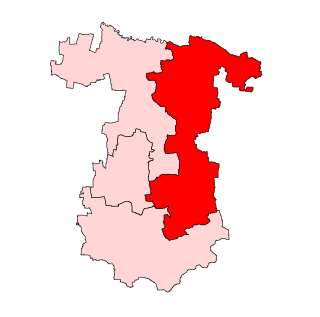
Trikuteshwara temple is a Hindu temple dedicated to Shiva. The carved temple is in the town of Gadag, 50 km southeast of Hubli-Dharwad, in Karnataka, India. It is dedicated to Shiva and has three lingas mounted on the same stone. There is a shrine dedicated to Saraswathi in this temple and it has carved columns.

Gadag district is a district in the state of Karnataka, India. It was formed in 1997, when it was split from Dharwad district. As of 2011, it had a population of 1064570. The overall population increased by 13.14 percent from 1991 to 2001. Gadag district borders Bagalkot district on the north, Koppal district on the east, Vijayanagara district on the southeast, Haveri district on the southwest, Dharwad district on the west and Belgaum District on the northwest. It is famous for the many monuments from the Western Chalukya Empire. It has seven talukas: Gadag, Gajendragad, Ron, Shirhatti, Nargund, Lakshmeshwar and Mundargi.

Gadag-Betageri is a city municipal council in Gadag district in the state of Karnataka, India. It is the administrative headquarters of Gadag District. The original city of Gadag and its sister city Betageri have a combined city administration. The municipality of Gadag-Betageri has a population of 172,813 and an area of 54.0956 km2 (20.8864 sq mi). Kanaginahal of Gadag is the birthplace of the first co-operative society in Asia. The temples of Veera Narayana and Trikuteshwara are places of religious and historic importance.

Gajendragad is a Town Municipal Council city in Gadag District, Karnataka, India with Population of 32,359 as of 2011 Census data and is located at 15.73°N 75.98°E. It has an average elevation of 643 metres (2109 feet). This place is known for its hill station,hill strip, film shooting spots, Fort, kalakaleshwara temple, Market for Javali / Dress Materials for marriage & festivals, windmills, Handloom. It is about 55 kilometers from the district head quarter Gadag, 110 kilometers from Hubli, 200 kilometers from Belgaum and 450 kilometers from state capital Bangalore

Bhimambika temple or Bheemavva temple, is a popular Mutt and temple located in the temple town of Itagi in Gadag District, Ron Taluk in Karnataka. It is About 13 km from Gajendragad Kalkaleshwara temple.

Magadi Bird Sanctuary created at the Magadi tank, it is one of the biodiversity hotspots of Karnataka.
Shirahatti is a panchayat town in Gadag district in the Indian state of Karnataka.
Shelawadi or Shelavadi is a panchayat town in the southern state of Karnataka, India. It is located in the Navalgund taluk of Dharwad district in Karnataka.
Bellatti is a village in the southern state of Karnataka, India. It is located in the Shirhatti taluk of Gadag district in Karnataka.
Hombal is a village in the southern state of Karnataka, India. It is located in the Gadag taluk of Gadag district.
Soratur also spelled as Soratooru is a village in the Gadag taluk of Gadag district in the Indian state of Karnataka. It is located in the Gadag taluk of Gadag district in Karnataka.
Abbigeri is a village in the southern state of Karnataka, India. It is located in the Ron taluk of Gadag district.
Adavisomapur (Gadag) is a village in the southern state of Karnataka, India. It is located in the Gadag taluk of Gadag district in Karnataka.
Korlahalli is a village in the Mundargi taluk of Gadag district in the Indian state of Karnataka. Korlahalli is located south of district headquarters Gadag and Taluka headquarters Mundargi.
Harlapur is a village in the Gadag district of Karnataka State in India.
Hotgi Junction is a railway junction station under Solapur Railway Division of Central Railway zone of Indian Railways located at Hotgi, suburb of Solapur.
Hubballi railway division is one of the three railway divisions under South Western Railway zone of Indian Railways. This railway division was formed on 5 November 1951 and its headquarter is located at Hubballi in the state of Karnataka of India.
Gadag Junction railway station is a NSG-4 Category railway station under South Western Railway in Gadag district, Karnataka. It serves Gadag-Betageri. The station consists of three platforms. The station lies on Guntakal–Vasco da Gama section HDN-7A and also connects the Gadag–Hotgi railway line. The Gadag–Hotgi railway line was converted from metre gauge to broad gauge in December 2008.
Bagalkot Junction railway station is a railway station in the Hubli railway division of South Western Railway in Bagalkote district, Karnataka, India. The station lies on the Gadag–Hotgi railway line, which serves Bagalkote and nearby towns with 3 platforms and was converted from meter gauge to broad gauge in December 2008. A new line is being constructed between Bagalkote and Kudachi. Railway stations have amenities such as a computerized reservation office, waiting room, retiring room book stall. It is a B category railway station.

Ron Assembly constituency is one of the 224 Legislative Assembly constituencies of Karnataka in India.
This page is based on this
Wikipedia article Text is available under the
CC BY-SA 4.0 license; additional terms may apply.
Images, videos and audio are available under their respective licenses.








